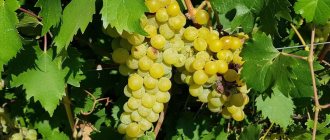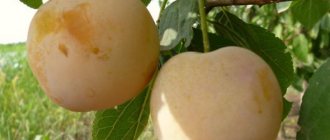Table grape variety “Monarch” (more precisely “Chrysolite”) is another masterpiece from the unique author’s collection of enthusiastic winegrower Evgeniy Georgievich Pavlovsky. The variety has received high marks from gardeners in different countries, primarily for its incredibly large berries, the visual effectiveness of which is combined with an excellent nutmeg taste.
The Monarch grape variety (pictured) is successfully grown in household plots in various regions of Russia
Due to its advantages, this relatively “young” variety is of interest to producers and summer residents. Let's start with its main characteristics, summarized in the table:
| Parameter | Characteristic |
| Culture | Grapes (Vitis Vinifera L.) |
| Variety | "Chrysolite" ("Monarch") |
| Growing conditions | Gardening |
| Direction of use | Dining room |
| Flower type | Bisexual |
| Bush growth vigor | Very big; high stepson educational ability |
| Ripening time | Early middle: third ten days of August – first ten days of September (126-135 days from the beginning of the growing season) |
| Consumption period (fruit shelf life) | Summer (autumn); in the refrigerator for more than 2 months |
| Precociousness | For the 4th year |
| Productivity of one bush per season | High: on average 12.4-15.8 kg (maximum up to 28-30 kg); in industrial plantings – 20.4-26.0 t/ha |
| Bunch shape and weight | Medium size, conical, moderately dense; weighing 600-800 g, maximum - over 1 kg |
| Fruit shape and color | Very large, oval, yellow, in the sun with a reddish tan. Firmly attached to the stalk. The skin is dense, you can’t feel it when eating |
| Fruit weight | On average 16-20 g (maximum - up to 32 g) |
| Pulp | Meaty, juicy, dense, crispy |
| Tasting assessment (taste qualities) | 8.2-8.8 points (out of 10) – harmonious taste with a slight nutmeg aftertaste |
| Purpose of fruits | Dessert type |
| Disease resistance | Weakly affected by mildew, gray mold, oidium - 2 points (out of 5) |
| Winter hardiness | Withstands frosts down to −25 ℃ (in most regions requires shelter for the winter) |
| Year of registration in the State Register of the Russian Federation | 2015 |
| Recommended growing regions | All regions of Russia |
| Originator | Federal State Budgetary Educational Institution of Higher Education "Kuban State Agrarian University named after. I. T. Trubilina" (Krasnodar) |
History of selection
According to the originator, the variety is the result of a combinative selection carried out by E. G. Pavlovsky in collaboration with specialists from the All-Russian Research Institute of Viticulture and Winemaking named after. Ya. I. Potapenko.” Some sources indicate that during breeding, “Talisman” and “Cardinal” + pollen mixture were used for crossing.
Grape varieties that served as parent forms: "Talisman" (left) and "Cardinal" (right)
At the end of the 90s of the last century, this hybrid form did not leave professional winegrowers indifferent and was actively tested both in farmer-amateur plantings and in experimental production farms in the Anapo-Taman, Foothill and Central zones of Kuban, as well as in the Don and Ukraine .
In 2013, “Monarch” was submitted for testing in the GSK RF system, under the name “Chrysolite”, and in 2015 it was officially registered in the State Register of Breeding Achievements as intended for private production of table grapes in all regions of Russia. “Chrysolite” is protected by a copyright certificate and a patent. Today, it is included in the list of 12 promising table varieties for Eurasia; it is successfully cultivated not only in Russia, but also in Ukraine, Belarus and other post-Soviet countries.
You can get acquainted with the features of “Monarch” in more detail from the video filmed by a Ukrainian amateur winegrower:
Photo of Chrysolite grapes.
Chrysolite grapes, harvest 2022. © Sergey Mansurov, Ust-Labinsk, Krasnodar region.
The last cluster of Chrysolite, © Ruslan Jalilov, Kerch.
Chrysolite grapes, © Irina Bosnyak, Kherson.
Chrysolite began to raisin, © Ruslan Jalilov, Kerch.
Description of the plant and specifics of cultivation
The vine is distinguished by very high growth vigor and good ripening of shoots, sometimes by 2/3 of the length. The perennial parts of the bush are covered with reddish, coarse-fibrous bark. Fruitful shoots range from 60 to 75%, on average the load on each is 1.1-1.3 bunches. Shoots that are too thin and grow from the head of the bush are not left for fruiting. To obtain a stable and high-quality harvest, experts recommend medium pruning (by 6-8 buds) of fruit shoots.
“Monarch” can produce a second full-fledged crop on its stepsons, ripening 2-3 weeks later than the main one. Experienced winegrowers recommend long pruning (10-12 buds) and, if the bush is underloaded with the main crop, early pinching in order to obtain a stepchild.
For full fruiting, “Monarch” does not require joint planting with other pollinating varieties
The leaves are large, dark green, five- or three-lobed (rare), slightly dissected. The petiole is open, lyre-shaped with a rounded bottom and a neatly cut jagged edge. The flowers are slightly greenish, small (3-5 mm in diameter), bisexual. During the flowering period and after it, the plant shows a tendency to shed flowers and ovaries, which, as a rule, leads to the formation of excessively loose (defective) bunches and, as a consequence, to a shortage of harvest and a deterioration in its marketable qualities.
The opinion of an amateur winegrower about agricultural techniques that reduce the shedding of flowers and ovaries can be found in the following video:
Reproduction
The easiest way to propagate grapes is to grow them from cuttings. Such cuttings are sold much cheaper than seedlings in the fall. Briefly about the technology:
- in the fall we cut cuttings into three buds from our bushes or purchase cuttings from winegrowers;
- we store the cuttings in the basement, cellar, if the quantity is small, then in the refrigerator;
- in March we take out the cuttings, update the cuts, sprinkle the lower cut with root or moisten it with Clonex gel, you can scratch small grooves at the lower cut, approximately 3 cm long, roots will actively develop from these “wounds”;
- We place the cuttings vertically in a container of water, making sure that the water does not evaporate completely, the lower part of the cutting should always be in water;
- After 14-20 days, roots will appear and the cuttings need to be transplanted into cups. as a nutrient mixture I use rotted manure, soil from the garden, sand in a ratio of 1:1:1;
- We plant seedlings in a permanent place when warm weather sets in and when the threat of return frosts has passed.
Productivity and ripening time
The plant produces its first signal harvest in the 2nd year after planting, marketable fruiting begins in the 4th - on average about 28-30 kg per bush.
According to the results of field tests in the natural conditions of Kuban (when bushes were placed according to a pattern of 3.0 x 1.5-2.0 m, formed like a horizontal cordon or a standard-less fan, and growth was carried out on a vertical trellis), five-year-old plantings demonstrated a yield of 12.4-15 .8 kg per plant or 20.4-26.0 t/ha. Moreover, during the growing season, care consisted of standard agrotechnical measures.
Removable maturity occurs 126-135 days after bud break . In the south this is approximately the third ten days of August, in the central zone - the beginning of September. The clusters can remain on the bush for a long time without deteriorating the quality of the fruit.
In industrial plantings, "Monarch" is capable of producing high yields of up to 26.0 t/ha
The berries are firmly held on the stalks and do not fall off even when harvesting is late. When picked correctly, the fruits do not spoil and are stored well in the refrigerator for more than 2 months. The juicy pulp is perfectly protected from damage by the dense skin, which is practically not damaged during transportation, so the variety is recommended primarily for industrial cultivation for commercial purposes.
You can get acquainted with the opinion of an experienced gardener about the yield potential of “Monarch” by watching the following video:
Landing
For the Monarch variety, as well as for others similar to it, chernozem soil is suitable, where groundwater lies at a depth of about one and a half meters. Swampy soil, sand and clay are contraindicated.
The soil must remain moist. Therefore, regular watering is important, especially in the absence of rain.
Additionally, the grapes are watered when they are preparing to bloom and when they fade. The rest of the time, watering above normal is not required. To better retain moisture, you can mulch the soil with humus, laying a layer of it three centimeters deep.
General planting recommendations:
- It is recommended to pre-soak the seedlings in water, adding a growth stimulator;
- It is better to dig holes for planting in advance, fill and water them so that the substrate has time to settle;
- The bushes require the most careful care within a year after planting.
Recommended planting schemes:
- On small private plots, Monarch grapes are planted along the walls or near gazebos, leaving at least one meter between the bushes. So that they have supports, horizontal trellises are placed, which help create a vineyard of the desired shape and suitable size.
- In fields, when growing many bushes at once, such trellises are also used. The grapes are planted in rows, so that there is a meter between the bushes in each row, and one and a half meters between the rows themselves.
Fruit characteristics
The clusters are not very large, conical, of medium density, weighing about 600-800 g, maximum - more than 1 kg. The berries are leveled: very large, without peas, do not crack, weighing on average 6-20 g, but specimens weighing 30-32 g are often found. In the main harvest, the fruits are ovoid in shape. The color of the skin is light green, when ripe it is yellow, with a reddish-pink blush. The skin is dense, but easy to eat.
The pulp is juicy, fleshy, dense, crispy, sweet, with nutmeg notes. Each berry has only two seeds, which are easily separated from the pulp. Professional tasting assessments of taste - 8.2-8.8 points (out of 10) , most summer residents find the taste “delicious” with bright notes of muscat and call it “amazing” grape.
Fruits for dessert (universal) purposes - excellent for fresh consumption; they are used for making jam, confitures, compotes, juices, raisins and other processing methods
Biochemical studies conducted by specialists from the branch of the Viticulture Department of Kuban State University revealed that in the conditions of the south of Russia, the sugar content of Monarch was 17.3-17.9% with an acidity of 6.4-6.8 g/l, at the level of Arcadia. (18.8%). The ratio of sugar and acid is balanced and harmonious, a pleasant nutmeg is felt.
Positive reviews about Chrysolite grapes.
One of our favorite varieties! Super! We have smaller berries, but I think there will be more. Two bushes. I'm not going to clean it up. (Irina Bosnyak, Kherson)
I also used to have a problem with berries falling off, and I kept Chrysolite for the collection and didn’t pay much attention to it, avoided it and did all the operations (pinching stepsons, removing idle shoots, thinning, etc.) for the last 2 years turn after tying the berries. The bush is powerful and only fruit shoots can be buried, and the bush overwinters without shelter. I don't do anything else to him. (slavaking777, Krasnodar)
Chrysolite grapes increase the cluster gradually, from year to year. There are simply no problems with it on the market, it is so attractive. Compared to Arcadia, the average Chrysolite berry looks very promising. The wasp, even without bags, is not damaged. (Alexander Moskalets, Stavropol Territory).
Pros and cons of the variety
According to experts, Chrysolite serves as the basis for the modern assortment of table varieties. Its main advantages are considered to be: large fruits with a pleasant nutmeg taste, excellent transportability, high productivity and the ability to produce a second full harvest on the stepsons. In addition, this variety of crop is weakly affected by mildew, gray mold and oidium.
According to gardeners, fairly high winter hardiness allows you to do without shelter for the winter, mainly in the southern regions of our country, and in the difficult climatic conditions of the central regions of Russia and to the north, it is recommended to grow these grapes in a covered crop.
The main varietal problem that gardeners may encounter when growing “Monarch” is the tendency of the ovaries and flowers to shed.
The main advantages are considered to be high yield and berries of “giant” size with excellent taste.
Where to plant Monarch grapes
This hybrid is a heat-loving plant. Without enough sunlight, the berries simply won't ripen on time. Also, the variety does not tolerate cold northern winds. For this reason, for planting grapes, it is better to choose areas that are located on the south side of buildings. It is not recommended to plant the plant in open areas.
Advice! Some yard buildings can not only protect bushes from the wind, but also serve as excellent support.
These grapes prefer light, moderately moist soils. But clay soil is absolutely not suitable for growing this crop. Grapes can grow on sandy soils, but young seedlings take root on them rather poorly.
It is best to plant Monarch grapes in black soil. Groundwater in the ground should melt at a depth of about 1.5 meters. If the water level rises, drainage should be done. To do this, make a wide depression or dig a ditch.
Reviews from gardeners
Irina, 38 years old, Krasnodar region
I have been growing this variety in our vineyard for many years. The bushes are vigorous. From the moment of planting with own-rooted seedlings, they practically do not get sick and do not “pea”. True, when the root system became stronger, the bushes began to fatten and shed buds even before flowering. We managed to solve the problem by pruning the fruit shoots to 6-8 buds, and before flowering, I don’t normalize the bushes at all: neither shoots nor inflorescences, until the berries are the size of peas. Then I do selective normalization. And for several years now I have been collecting an excellent harvest: about 15-20 kg from one bush. The berries are shaped like quail eggs, even, each “giantella” weighing 20-30 g. The pulp has a nutmeg taste, melting in the mouth, with a small seed. I'm not going to give up this pleasure. I am glad that I found a common language with these grapes.
Vladimir, 46 years old, Moscow region
On our site, the only “Monarch” bush grows not very well, in partial shade. This year I tracked the dynamics of changes in its taste, taking samples twice a week. The harvest is fully ripe at the end of August. The taste of the berries was quite decent, but simple, grapey. Over the next two weeks, it became significantly richer and became pleasant and aromatic. After a while, despite the rains, a pronounced nutmeg and delicate sweetness appeared. In my opinion, its taste is simply outstanding. “Arcadia”, “Gift to Zaporozhye” and “Troika Krainova” are capable of similar metamorphoses.
Evgeniy, 60 years old, Lugansk
I like the variety. The growth vigor of the bushes is above average. The vine, even when fully loaded, ripens well. This season, 30 full clusters of Chrysolite were ripe by the first of September. The brushes are medium in size, but due to the weight of the berries they pull more than a kilogram. The fruits are delicious, you can’t feel the skin when eating, the flesh is crispy and sweet. With standard care, regular watering and treatments, it does not get sick and does not “crack”. I plan to plant a couple more seedlings from my cuttings.
Caring for Monarch grapes
Caring for Monarch grapes consists of the following simple steps:
- regular watering;
- mineral and organic fertilizers;
- pruning;
- shelter for the winter;
- prevention of diseases and pests.
Grape bushes need to be watered infrequently. This plant requires more moisture only during drought. If the soil where the grapes grow is dry and quickly evaporates moisture, then you may also have to water the plant more often. If there is no special need, then the bushes are watered only in two cases: before flowering and during the period when the ovaries begin to form. Next, you need to monitor the condition of the plant and soil. If necessary, additional watering of the grapes is carried out.
To retain moisture in the soil, you can mulch the soil around the bush. A variety of materials and substances are suitable for this. For example, ordinary humus will do the job perfectly. It is poured out and distributed around the bush so that the thickness of the mulch is no more than 3 cm.
Fertilizing Monarch grapes is carried out simultaneously with loosening the soil. For this purpose, special fertilizers based on potassium and phosphorus are used. They are introduced into the soil and dug up, simultaneously deepening the substance.
Attention! Fertilizer cannot simply be distributed over the surface of the soil. In this case, it simply will not be absorbed.
Grape bushes begin to be pruned at a time when they are dormant. It is also necessary to thin out the shoots. This is done after the berries are formed. Only 4 or 6 eyes should be left on each sleeve. In general, about 40 buds are left on each bush. There is no need to spare the vine when pruning. Leaving more branches than needed will simply reduce the yield of the bushes.
The monarch is highly resistant to various diseases. However, it is often affected by powdery mildew. To protect the plant from a destructive disease, it is necessary to carry out timely prevention. Bordeaux mixture is perfect for this. A 1% solution is prepared from it, and then the bushes are simply treated with the solution.
This hybrid tolerates severe frosts well. Therefore, plants need to be covered only in regions where the winter temperature drops below -25 °C. Before this, high-quality pruning of the bushes is carried out. Then they are laid on the ground and covered with hay. From above you need to cover everything with plastic film, which is firmly attached to the ground. In this form, water will not flow under the shelter and it will not be blown away by the wind.
Advice! If the winter in your area is warmer, then it will be enough to simply mulch the soil around the bushes. Sawdust and moss are used for these purposes.
Botanical description of the variety
Monarch grapes are one of the best white varieties. Users are attracted by the massiveness of the bunches, the mid-early period of ripening, as well as the pleasant taste.
Monarch grapes are one of the best white varieties
Taste characteristics
The chemical composition of the fruit is presented as follows:
- sugar content – 16-18%;
- acidity – 4-5 g/l.
The fruits of the Monarch grapes are characterized by a pleasant soft taste with a harmonious content of acid and sugar. There are pleasant shades and aroma of nutmeg.
Features of cultivation
The remarkable characteristics that this grape hybrid possesses make it quite popular for cultivation among amateur country winegrowers. In addition, Monarch grapes are quite unpretentious, and the harvest will be the envy of all neighbors.
Landing location
Choosing a location and planting grapes, followed by their trouble-free cultivation, involves following the following rules:
- It is better to locate the vineyard on the south side of the site, in a sunny place protected from the winds;
- fruit trees should be adjacent to vineyards at a distance of 3-5 meters;
- The hole for the seedling is dug to a depth of about 80 cm, humus mixed with fertilizers and soil is placed in it, and just soil is placed on top.
On a note! In case of increased soil moisture, another 15 cm is added to the depth, and the bottom is covered with drainage. Its role can be played by broken bricks and wood scraps. They will also hold the soil layer, preventing it from sagging.
- The grape seedlings are carefully lowered into the hole, preserving the roots, then they are dug in with earth, compacted and watered abundantly (a couple of buckets of water).
It is best to plant Monarch grapes in chernozem soil with a 1.5-meter groundwater table. Clay soil, wetlands and sand are unsuitable for vines.
Watering and fertilizing
Monarch grapes, especially those growing on sandy soil, require careful attention to watering, because... loves a humid environment. Additional watering should be carried out during the period before flowering and immediately after its end.
For the convenience of watering, when planting a grape seedling, a pipe with the end sticking out on the surface is dug nearby. This simple device will allow you to avoid eroding the soil around the bush when watering and will deliver moisture directly to the roots of the vine.
On a note! To preserve moisture and improve the properties of the soil, a mulching procedure is used - covering the surface of the ground with humus (about 3 cm thick).
Monarch grapes respond well to potassium- and phosphorus-containing fertilizers. Additional fertilizing should be applied taking into account the characteristics of the growing area.
Pruning and wintering
To avoid shedding of the ovary during the pollination period, this hybrid should be pruned in late spring, after the berries begin to grow and form to the size of peas.
When pruning, you can leave large developed clusters, then you will get a harvest with medium-sized berries, or small clusters, then a small number of berries on them will allow the fruits to reach impressive sizes.
The good frost resistance indicators indicated in the description of the Pavlovsky Monarch grapes make it possible not to use bush shelter in the southern regions. However, in colder areas, winter protection should not be neglected to protect the vines.
Diseases and pests
Against the backdrop of all the wonderful qualities of this grape variety, its vulnerability is its low resistance to disease. And if it is enough to carry out ordinary preventive treatments against mildew, then the vine may turn out to be completely helpless in the face of oidium.
To combat oidium, preparations with colloidal sulfur have proven themselves to be effective. This is a time-tested method that not only protects against powdery mildew, but also inhibits the vital activity of mites - one of the most unpleasant pests for plants. These preparations are also good because they do not accumulate in the tissues of grapes, thus causing no harm to the consumer of the fruit.
On a note! The most important thing in processing grapevines and using such preparations is to strictly follow the instructions for use. This applies not only to the dilution dosage, but also to the use of protective equipment - a suit, gloves, a respirator.
Another problem that can harm the grapevine is phylloxera, an insect about 1 mm long that feeds on the roots. At one time, phylloxera caused great harm to European viticulture, since the vine was not resistant to this small pest imported from America.
To combat this fly, various insecticides are used: hexachlorobutadiene, carbon disulfide emulsion. In addition to this method of pest control, there is another one - grafting grapes onto phylloxera-resistant American rootstock.
Harvest storage
At the end of August, the Monarch grapes, subject to all the rules of agricultural technology, give their unique harvest. You need to collect it manually, carefully cutting off the brushes with pruning shears. For better preservation, the fruits are placed in wooden boxes. Some of the berries can be left on the bushes. Indeed, according to the description of the Monarch grape variety, they are able to hang on the bushes for a long time and not fall off.
The harvested crop is stored in a cool place. The bunches are periodically inspected to get rid of spoiled and rotten berries. For longer storage, the brushes are hung on twines, with small potatoes placed on the sections of grape branches. They will nourish the berries for some time and prevent them from drying out.
Reviews from winegrowers growing Donskoy Agat
Arefkin A.M., Serpukhov, Moscow region.
https://vinograd7.ru/docs/vernisazh/podrobno/agat.htm
Yuri Nikolaevich, Penza
https://vinograd7.ru/docs/vernisazh/podrobno/agat.htm
Anatoly BC
https://forum.vinograd.info/showthread.php?t=1068
therapist
https://forum.vinograd.info/showthread.php?t=1068&page=3
Photo gallery
Characteristics of berries
The bunches of the “Monarch” variety are large in appearance, but their weight usually does not exceed 1 kg. They can be conical or cylindrical in shape, placed on a branch with medium density. The berries have a pronounced oval shape, with a slight narrowing at the bottom. Their dimensions do not exceed 3.6x2.6 cm and weigh 19 g. The color of the grapes is amber-yellow, with a slight tan on the sunny side.
The taste of Monarch grapes is somewhat reminiscent of muscat varieties, at least this is the aftertaste that remains after eating the sweet and dense pulp. 100 g of fruit contains 16–18 g of sugar, with an acidity of 4–5 g per 1 kg. The skin of the berries is relatively thin, making it practically invisible when eating. The pulp of each berry contains no more than two seeds.
The shoots of the described grapes grow very quickly, and from one medium bush it is possible to collect about 7 kg of tasty fruits that are not prone to cracking.
Important! The optimal load on the grapevine is no more than 23–35 buds per bush, which should be taken into account when pruning.
Advantages and disadvantages of the variety
Any grape variety has its advantages and disadvantages, which you should definitely know about before planting seedlings.
- The list of advantages of "Monarch" includes the following features:
- excellent external data of the bunches, thanks to which it can be grown for further sale;
- high taste characteristics with a noticeable aftertaste;
- reduced likelihood of rotting and lack of grape peas, regardless of weather conditions;
- excellent rooting of cuttings;
- good frost resistance (up to –25ºС without shelter);
- high level of resistance to typical grape diseases such as mildew or gray fruit rot.
- As for the disadvantages of the Monarch variety, there are much fewer of them. The main ones include:
- tendency to massive shedding of ovaries;
- the need for rationing of shoots during the formation of grapes.
Also, one should not exclude the possibility of the vine being affected by powdery mildew, but this probability can be easily reduced with timely implementation of preventive measures, in particular, spraying the plants with appropriate fungicides (for example, “Topaz”, “Skorom” or “Acrobat”).
Negative reviews about Chrysolite grapes.
All my friends are massaging Chrysolite. The reason is the shedding of the ovary during flowering. I’m still holding it in the hope of finding an approach. The taste and size are simply magnificent, but when 3-5 berries remain on the inflorescence from year to year, there is no point in keeping it. I broke the tops during flowering and treated them with boron, but there was no result. It’s a shame to say goodbye to the variety, but I’ll probably have to. (Oleg Binko)
For the third year, the ovary falls off. (Alexey Kondratenko).
In fact, in my conditions there is low yield and poor pollination. Yes, the berry is big, but it’s not enough, and it’s better to eat grapes. The same Bazhena, for example. (Irinna S, Kamenskoye, Ukraine).
Possible diseases and pests, preventive procedures
Monarch grapes are characterized by increased resistance to most diseases characteristic of this crop. To avoid problems, you should regularly carry out preventive spraying and ensure that the plant maintains high immunity. But there are a number of problems that are receiving increased attention.
Arthroknosis
Anthracnose is a dangerous fungal disease that affects the green part of the vineyards. Gray spots appear on the leaves. Gradually, the disease leads to the loss of greenery. Under the influence of the fungus, the shoots become brittle and brittle.
If timely treatment is not carried out, the fungus will also attack the berries, which will lead to their cracking.
It is best to engage in treatment in the early stages of the disease. The following drugs show effectiveness in prevention:
- Ridomil;
- Bordeaux liquid.
For spraying, choose a windless day when no precipitation is expected. It is best to carry out the procedure in the early morning or evening.
When the first signs of the disease appear, a course of spraying with the following preparations should be carried out:
- Mikosan;
- Gaupsin.
In addition to eliminating the fungus, they additionally stimulate the growth of green mass and young shoots. To prevent further spread of the fungus, additionally treat with copper-based products:
- Polisher;
- Carticide.
To prevent the spread of the fungus, they are additionally treated with copper-based products.
The first treatment is carried out after the young shoots have reached a length of 10 cm.
Phylloxera
Phylloxera is a dangerous disease for grapes, which is caused by a microscopic insect - yellow aphids. It feeds on the sap of all parts of the plant; the most dangerous is damage to the root system. For control, the ground part is treated with insecticides:
- Confidor;
- Mitakom;
- Zolon.
One treatment is not enough; spraying is carried out in several stages:
- after the first 2 leaves appear;
- after formation on the vine there are 12 leaves;
- when 18 leaves are formed.
Aphids do not like sandy soils, so when planting, consider this option as pest prevention. If the Monarch grape is at the epicenter of the attack, it will not suffer on sandstone.
Phylloxera is a dangerous disease for grapes, which is caused by yellow aphids.
Birds
Since the berries are not prone to cracking, they are rarely attacked by wasps. Birds pose the greatest threat to vineyards. They happily peck at the berries, spoiling the largest ones.
But the pecked berries attract wasps, which are not averse to enjoying the juice of delicious grapes.
To scare away feathered guests, shiny objects and noisemakers are hung in the vineyard. If the plantations are not too extensive, the bushes are covered with a net with small cells. Do not use a fishing net; birds often get entangled in it and die.
To protect the grapes from birds, they cover them with a fine mesh
Scheme of fertilizing and processing of grapes
The first spraying of the grapevine is carried out in early spring in order to prevent various diseases.
Each winegrower has his own processing scheme. Particularly experienced people share their experience, but are happy to check other people’s work on this matter. Having tried several schemes on varieties with approximately the same damage in the same year, a fairly effective treatment scheme was formed:
- During the period of bud opening, it is necessary to use the drug “Tiovit Jet 800 WG” in a concentration of 40 g per bucket of water (10 liters).
- The initial growth of the leaf, when it is the size of a nail plate, use the drug “Topaz 100 ES” 6 ml per bucket of water.
- Before flowering " Quadris 250 SC " 6 ml per bucket.
- Immediately after the end of flowering “Ridomil Gold MC 68 WG ” 50 g ha bucket.
- During the period of berry growth " Ridomil Gold MC 68 WG " 50 g ha bucket.
- Repeated spraying during berry growth after 3 weeks with “ Quadris 250 SC ” 12 ml per bucket of water.
In summer, foliar feeding of grapes is recommended - spraying the foliage with an aqueous solution of nutrients.
If the weather is not favorable, then treatments should be carried out with the drug “ Switch 62.5 WG ” every 12–15 days until the waiting period is observed before harvesting the berries, and for this drug it is short - only 7 days.
As can be seen from the diagram, fungicidal preparations are constantly changing. Thanks to this, addiction and accumulation of decay products in the vine, leaves, soil, and even the berry itself do not occur.
Gone are the days when it was enough to spray with copper sulfate once and get a good effect. European varieties are very sensitive and require constant, regular care to obtain the highest quality berries.
Seasonal care, pruning and fertilization
It is preferable to do pruning in the spring, before the growing season, to stimulate active growth of shoots. On bushes that are more than 5 years old, pruning is also done in the fall to rejuvenate the bush.
In summer, weeds are carefully removed and watered. In dry summers, water the plant at least once every 7 days. In the northern regions, Monarch grapes are wrapped in agrofibre for the winter. If winters in your region are harsh, it is recommended to choose varieties that are more cold-resistant.
In the spring, pruning is done and liquid nitrogen fertilizers are applied. For preventive purposes, twice a year, experienced summer residents are advised to treat grapes against pests with any preparations. You can buy them at any agricultural store or garden markets.











